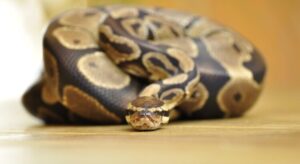The ball python emerges as a serpent of distinction, quietly weaving its way into the hearts of those seeking a unique and enigmatic companion. Far from the ordinary, these sleek and fascinating creatures defy the stereotypes associated with their reptilian counterparts. That brought us to the question are ball pythons good pets?
Yes, ball pythons can make good pets due to their calm temperament, manageable size, low maintenance, beautiful color variations, long lifespan, adaptability, and educational value.
Owners find joy in the rewarding experience of caring for these captivating reptiles, appreciating the unique bond formed with a creature that, despite its exotic nature, offers companionship and a glimpse into the fascinating world of reptilian behavior.
Are ball python good pets?

Ball pythons (Python regius) are commonly kept as pets and can make good companions for the right owner. However, it’s essential to consider some factors before deciding if a ball python is the right pet for you:
- Size: Ball pythons are relatively small compared to some other snake species, but they can still reach lengths of 3 to 5 feet. Make sure you’re prepared for the space requirements of their enclosure.
- Lifespan: Ball pythons have a long lifespan, often living 20 to 30 years in captivity. Be ready for the long-term commitment that comes with caring for a snake.
- Habitat: Provide a proper and secure enclosure for your ball python. They need a temperature gradient within their enclosure, with a warm side and a cool side, as well as hiding spots.
- Feeding: Ball pythons primarily eat mice and rats. Feeding frequency depends on the snake’s age, but they are generally fed every 1-2 weeks. Some individuals may be picky eaters, which can be a concern for some owners.
- Handling: Ball pythons are generally known for their docile nature, but individual temperaments can vary. Regular, gentle handling can help build trust between you and your snake.
- Healthcare: Like all pets, ball pythons require regular veterinary check-ups. Make sure you have access to a qualified reptile veterinarian.
- Legal Considerations: Ensure that it’s legal to keep ball pythons as pets in your area. Some places have restrictions on certain species of snakes.
- Allergies and Health Concerns: Some people may be allergic to snake dander, and handling reptiles carries a slight risk of transmitting salmonella. Practice good hygiene, especially after handling your snake.
If you’re willing to invest the time, effort, and resources needed to provide proper care for a ball python, they can make fascinating and rewarding pets. However, it’s crucial to educate yourself about their specific needs and behaviors before bringing one into your home.



